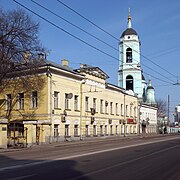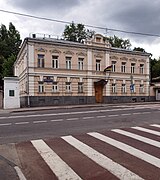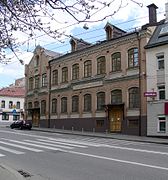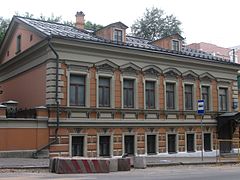Nikolojamskaya Street
The Nikoloyamskaya Street ( Russian Николоямская улица Nikoloyamskaya Ulitsa ) is a road in the district Tagansky in the Central Administrative District of Moscow lies. It leads from Jausskaya Street to Andronjewskaya Square and crosses the Garden Ring (section Zemlyanoj Wal )
history
The street was named after the church of St. Nicholas na Jamach . Jamy (russ. Ямы ) is the short name of Yamskaya Sloboda - a place where Jamschtschiken ( carters ) lived. "Na Jamach" means "near Jamskaya Sloboda". Nikiloyamskaya Street was built as part of the route from Moscow to Vladimir at the time . Jamskaya Sloboda has existed here since the 16th century and was located at the end of the street, near Andronevskaya Square. At the beginning of the street was the Jausski Palace for Peter the Great in the late 17th century . The first church of St. Nicholas was built from wood in the 17th century, the stone church was built at the beginning of the 18th century, after which it was built over several times. The last development was carried out under the architect Nikolai Finisow from 1867 to 1882. Matrona Moskovskaya lived for some time at the church. During the Soviet rule in 1928 the church was closed for services, partially demolished and used as a storage room. 1956–1957 it was completely demolished. The street was built on in the 18th and 19th centuries with single houses for merchants, some of which are now designated as state cultural objects of particular importance. Among other things, representatives of the Schelaputin merchant family lived here, which is why an adjacent street - Schelaputinski-Gasse - took this name. Tenement houses were also built in the late 19th to early 20th centuries. After the October Revolution of 1922 it was renamed Ulyanovskaya Street in honor of Lenin (Ulyanov). In 1994 the street got its old name again.
description
On the side with the odd house numbers are among others:
- House number 1 The Russian State Rudomino Library of Foreign Literature. Founded in 1921, the first director was Margarita Rudomino. The library was originally located on Deneschnygasse and had a relatively small collection that arose from private collections of noble families that were confiscated after the revolution. But after the war ended in 1945, millions of books were carried away from Germany as spoils of war . There was a need for a large new building for the library. But it was not until 1967 that a new building was built by Dmitry Chechulin . Originally the site of the Jausski Palace of Peter I.
- House number 13, building 1 - a residential building from 1888 by the architect Bernhard Freudenberg . Behind this building is a modern building (address 13, G.2), in which the Austria Institute was opened in 2018 in the presence of Karin Kneissl
- House number 19 is a tenement house from 1907. The architect is Mikhail Prijomyshev.
- House number 21/7, Building 3 A residential building from 1900. The architect is Vladimir Vlastov.
- House number 39 residential building from 1957 on the site of the demolished Nikolaus Church
- House number 49 The manor house Weschnjakow-Salogina. Construction period 1754 to 1760s. A cultural monument under monument protection.
- House number 51 18th century mansion, wing from 1850s. The Institute for Geoecology is now located here.
- House number 53, 55 mansions from the 19th century.
- House number 59 The Church of Venerable Sergius of Radonezh in Rogozhskaya Sloboda. Built in 1818, rebuilt from 1834 to 1838 by the architect Fyodor Shestakov. From 1938 to 1991 the building was closed for services.
On the side with the even house numbers are among other things:
- House number 4 The residential building of the church workers of the Church of St. Stephen from 1891. The architect is Flegont Woskresenski. The Institute for Translation is now located here.
- House number 8 The two-story residential building from the 19th century. The embassy of Mauritius is located here .
- House number 10 The Church of the Venerable Symeon Stylites behind the Jausa . Was built from 1792 to 1813, probably by the architect Rodion Kazakow in classicism. Until then there was first a wooden church (since 1600), then a first stone church. Bell tower from the second half of the 19th century. From 1926 (or 1929) to 1995 it was closed for services and the bell tower was demolished.
- House number 12 The residential building of church workers of the Symeon Church. Was rebuilt several times at the end of the 17th century.
- House number 20/1 is the Moscow Center for Speech Pathology and Neurorehabilitation.
- House number 42 The building for the city school was built in 1883–1884 at the expense of the businessman Nikolai Alexejew. The architect is Dmitri Tschitschagow. Now the NA.-Alexejew-Musikschule №30 is located here.
- House number 52 The house from the 18th century, was rebuilt in the 19th century. Restored in 2015–2017.
- House number 60 The Church of Metropolitan Alexius of Moscow in Rogozhskaya Sloboda . The architect is Dmitri Uchtomski . Was built between 1748 and 1751.
The Mauritius Embassy












